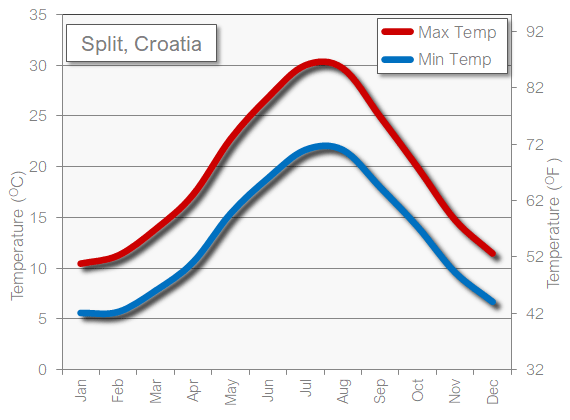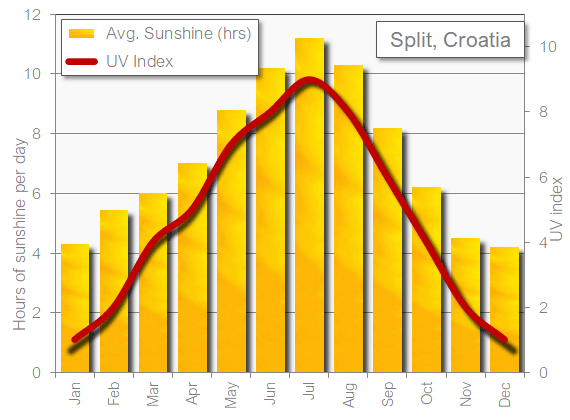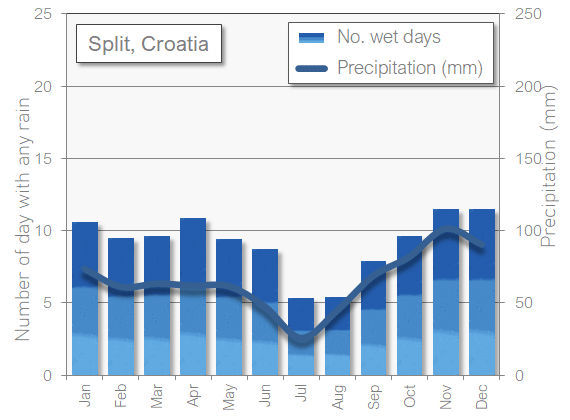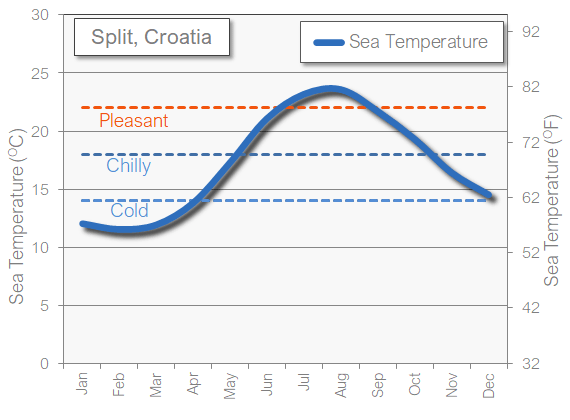Split, Croatia in July - The weather and is it a good time of year to visit?
Split, Croatia's second-largest city, is a vibrant coastal gem on the Dalmatian Coast. This ancient city boasts a rich history dating back to Roman times, evident in its stunning architecture and well-preserved Diocletian's Palace. With its Mediterranean charm, bustling waterfront, and lively atmosphere, Split offers visitors a perfect blend of culture, history, and seaside relaxation. The city's narrow stone streets, vibrant markets, and charming cafes create an enchanting ambiance that captivates tourists from around the world.
July is indeed an excellent time to visit Split, as the city comes alive with summer energy. However, it's worth noting that this is also the peak tourist season, meaning larger crowds and higher prices. The weather is ideal for beach activities and outdoor exploration, but the heat can be intense during midday. Despite the busier atmosphere, July in Split offers an array of festivals, events, and optimal conditions for enjoying the Adriatic Sea and the city's numerous attractions.
Overview of Split's Climate in July
July in Split epitomises Mediterranean summer at its finest. The weather is characteristically hot and dry, with abundant sunshine and clear blue skies dominating most days. This month marks the height of summer in the region, bringing warm temperatures and minimal rainfall, perfect for those seeking a sun-soaked holiday by the Adriatic Sea.

July is one of the hottest months in Split, with temperatures soaring to their annual peak. During this time, you can expect daytime highs to regularly reach 30°C (86°F), sometimes climbing even higher to 35°C (95°F) during heatwaves. The average daily temperature hovers around a warm 25°C (77°F), providing ideal conditions for beach activities and outdoor exploration.
Evenings in Split during July offer a welcome respite from the daytime heat, with temperatures typically dropping to a more comfortable 20°C (68°F). However, it's worth noting that some nights can remain quite warm, especially in the city centre where stone buildings retain heat. The pleasant evening temperatures make it perfect for enjoying al fresco dining or strolling along the Riva waterfront promenade. Overall, you can expect consistently hot and pleasant weather throughout your July visit to Split.

July in Split is characterised by long, sun-filled days, offering ample time for sightseeing and outdoor activities. You can expect around 15 hours of daylight, with sunrise occurring early, typically around 5:30 AM, and sunset extending well into the evening, often past 8:30 PM. This extended daylight provides an excellent opportunity to make the most of your holiday and explore all that Split has to offer.
Sunshine is abundant in July, with the city basking in an average of 12 hours of bright sunshine per day. Clear, cloudless skies are the norm, allowing for uninterrupted sunbathing and outdoor adventures. While occasional clouds may appear, they rarely obstruct the sun for long periods. The intense Mediterranean sun during this time of year creates perfect conditions for beach-goers and sun-seekers, but it's essential to take proper precautions to avoid sunburn.

July is one of the driest months in Split, with minimal rainfall and very low humidity. On average, you can expect only about 28mm of precipitation spread across just 3 to 4 days throughout the entire month. When rain does occur, it's usually in the form of brief, light showers that quickly give way to clear skies.
The likelihood of experiencing a rainy day during your July visit to Split is quite low. Heavy downpours are rare, and when they do happen, they tend to be short-lived and often provide a refreshing break from the heat. The low humidity levels contribute to a comfortable atmosphere, despite the high temperatures, making it easier to enjoy outdoor activities without feeling sticky or uncomfortable.

The Adriatic Sea surrounding Split reaches its most inviting temperatures in July, making it an ideal time for swimming and water activities. Average sea temperatures during this month hover around a pleasantly warm 24°C (75°F), providing perfect conditions for extended periods in the water.
These warm sea temperatures are suitable for all types of swimmers, from children to adults, and even those who might usually find the water a bit chilly. The comfortable water temperature allows for enjoyable snorkelling, diving, and various water sports. Whether you're planning to relax on the popular Bačvice Beach or explore the quieter coves along the coast, you'll find the sea temperatures in July to be refreshingly comfortable and conducive to long days of seaside enjoyment.
Clothes to pack for July in Split
Visiting Split in July calls for a summer-ready wardrobe. During the day, lightweight clothing, such as breathable shirts, shorts, and dresses, are ideal. Don't forget your swimsuit for those inviting dips in the Adriatic. Evenings can still be warm, but it's worth packing a light jacket or cardigan for when the sun sets and a cooler breeze rolls in from the sea. Comfortable shoes are also a must, especially if you plan on exploring Split's charming Old Town with its cobblestone streets.
The best months to visit Split
The best months to visit Split are arguably May, June, and September. May ushers in the summer with comfortable temperatures and fewer crowds, making it an excellent time for sightseeing and outdoor activities. June brings warmer weather and the start of many summer festivals, striking a balance between activity and relaxation. September, meanwhile, offers warm sea temperatures and slightly cooler land temperatures, providing a relaxing retreat after the peak summer rush, with lower prices and fewer tourists.
The worst months to visit Split
November and December are potentially the least favorable months to visit Split. The Mediterranean climate gives way to colder, wetter weather, and while it's far from harsh winter, it's not ideal for beach-going or many outdoor activities. Additionally, many tourist amenities may be closed or operating on limited hours. However, if you enjoy quieter streets and a slower pace of life, these months can offer a different perspective on the city.
Fantastic activities for Split during July
Diocletian's Palace: No trip to Split is complete without visiting this UNESCO World Heritage Site. This Roman emperor's palace is a living monument, blending seamlessly with modern-day houses, shops, and cafes. The intricate network of alleys, squares, and magnificent architecture is a captivating step back into history.
Marjan Hill: For breathtaking views over Split and the Adriatic Sea, head to Marjan Hill. A walk or cycle up this forested park offers a respite from the city heat. The sunset views from the top are nothing short of spectacular.
Beach Hopping: With the Adriatic Sea at its doorstep, Split offers a plethora of beautiful beaches. Bacvice beach is a popular sandy spot, perfect for a relaxing swim and engaging in the local game of "picigin," a sort of aquatic keepy-uppy.
Island Excursions: Split is a gateway to the idyllic islands of Hvar, Brac, and Vis. Day trips are easily organized, offering opportunities for more beach time, wine tasting tours, or exploring quaint island towns.
Green Market (Pazar): Experience local life at Split's bustling green market, where vendors sell everything from fresh produce to homemade cheeses. It's an excellent spot to pick up local delicacies for a picnic.
Riva Promenade: The vibrant Riva Promenade is the heart of Split's social life. Lined with cafes, bars, and shops, it's a perfect place for people-watching, sipping a coffee, and enjoying the atmosphere.
Rafting on the Cetina River: For the adventurous, white-water rafting on the Cetina river